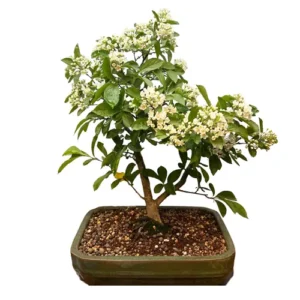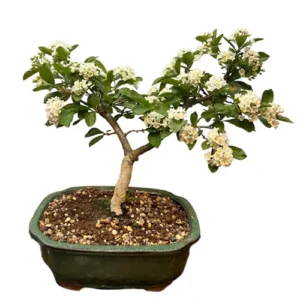Ilex aquifolium
Common Holly Bonsai
Native to Europe, North Africa and West Asia. This hardy evergreen is famed for its rich spiky green leaves and glossy bright red fruit. Though the iconic fruit is not for human consumption, it provides a feast for birds in the winter.
Common Holly Bonsai Care Tips
Placement
While Holly is a hardy species, it should be given some protection from hard winter first due to the tender nature of its roots. Choose an outdoor location that provides full sun with the option for some shade on the hottest summer days.
Watering
Throughout the growing season water your Common Holly consistently. Do not let the tree dry out entirely. During the winter keep the soil moist.
Feeding & Fertilising
During the growing season, feed your Common Holly bonsai with a low-strength feed every two weeks. Consider using a fertiliser rich in nitrogen during the spring and one lower in nitrogen towards the end of summer.
Pruning & Wiring
Pruning your bonsai is important not only to create or maintain an aesthetic style but to also ensure optimal health. Throughout the growing season, you can prune new shoots. Do not remove any of the current growth, if seeking flowers and berries in the year ahead.
Common Holly is suitable for all styles except broom. Wiring is best done during the early spring or winter. Spiny leaves can be difficult to wire so proceed carefully. We recommend using wires with a thickness that matches the thickness of the branch: if the wire you choose is too thick you will damage the bark. If it is too thin, it won’t be effective.
Repotting
Repotting your tree is an important way to provide a fresh and suitable soil mix and ensure appropriate root health. Repot your Common Holly every 3-4 years as and when the roots become pot bound.
Trees that are ready for repotting will require root pruning, a suitable new pot and appropriate soil mix.
When repotting, do not cut back the root mass by a large amount, and choose a well-draining soil mix that has a neutral or slightly higher PH value of 5-6 but not over 7. We tend to use a mixture of different speciality bonsai soils on our trees. Every species is different so please contact us for free soil-mix advice or to take advantage of our repotting service.
Bonsai trees aren’t only magnificent additions to an indoor oasis, they are more than capable of standing out in any garden. Many Bonsai species are incredibly hardy and withstand nature’s colder and damper turns with aplomb making them worthwhile outdoor plants. We have an extensive library of care guides for outdoor bonsai trees. It’s not about selecting the perfect bonsai, it’s about selecting the perfect bonsai for you.
The Ilex genus is a species of trees, shrubs and climbing plants that totals over 500. Typically these are hardy plants with glossy and tough leaves making them far from easy to style. Further Ilex species that are commonly used for bonsai include the Japanese Winterberry and the Japanese Holly. These deciduous and evergreens make for challenging and rare bonsai specimens but are popular with hobbyists worldwide.
Common Holly Bonsai - Typical Queries
How to propagate Common Holly bonsai?
Common Holly can be propagated with cuttings, seeds and air-layering. As an evergreen, Common Holly is best propagated through cuttings. The current year’s green wood is the best choice for cutting propagation. Seed germination takes a considerable amount of time some two to three years as well as a lengthy cold stratification beforehand.
Do Common Holly bonsai get pests and diseases?
Scale and aphids are the likely pests for this species. This should be easily dealt with by picking off by hand. If this doesn’t suffice or facing an infestation, an appropriate insecticide will suffice. Too much fruit can leave the tree weaker than otherwise consider this for its overall health.
Is Common Holly a good bonsai for beginners?
While accessible Common Holly is not advisable for beginners and doesn’t make for a common species. While its watering can be a little fiddly and take some vigilance to get right, the main issue is its stiff and unruly foliage. There are better choices for the beginner.





















